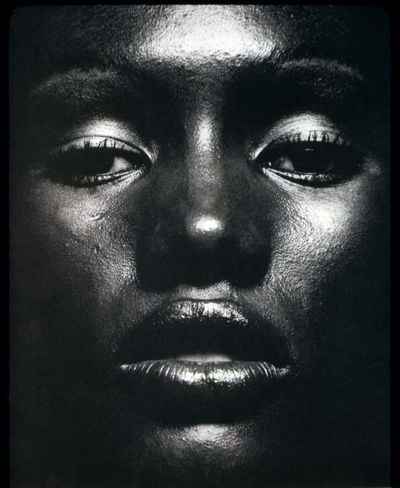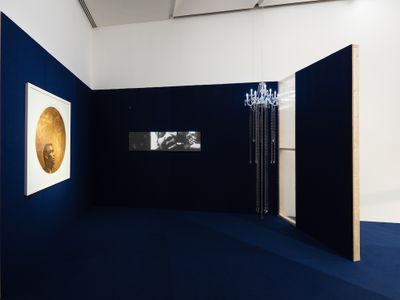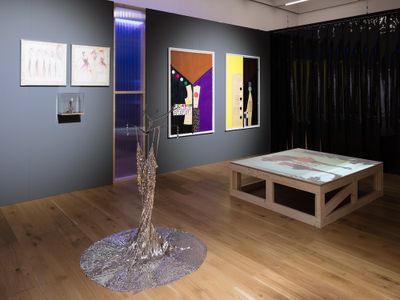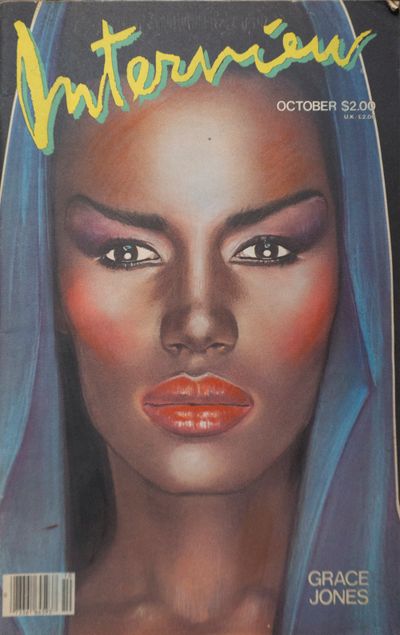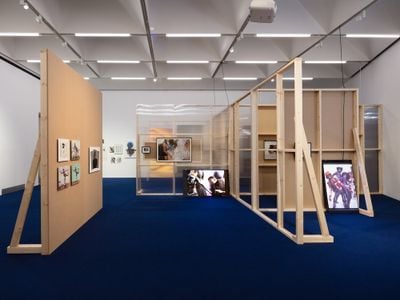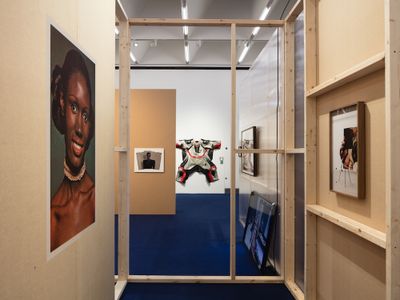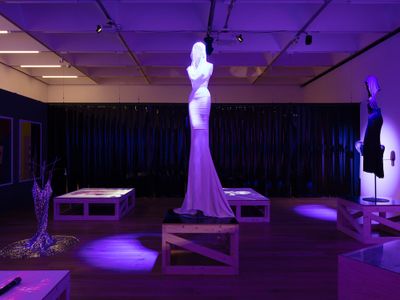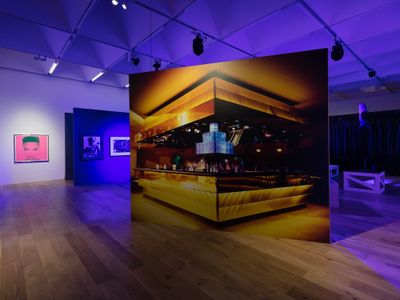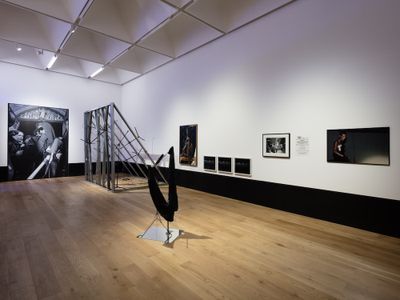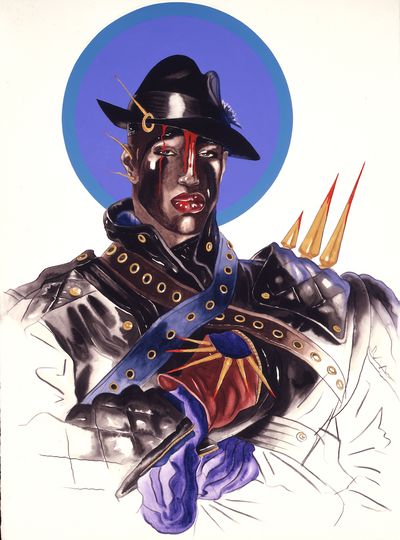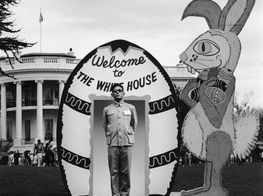Grace Before Jones: Black Image-Making and the Gaze

Richard Bernstein, Inside Gatefold for Muse (1979). Courtesy the Estate of Richard Bernstein.
Grace Before Jones: Camera. Disco. Studio (26 September 2020–18 April 2021) is a grandiose exhibition centred around the pop culture icon Grace Jones.
Curated by Cédric Fauq with Olivia Aherne at Nottingham Contemporary, works by 61 artists and collectives are spread across two galleries, including Chief with History Behind Him (1987) by El Anatsui, a beautiful reproduction intaglio etching of a Ghanaian chief wearing a ceremonial garment, and Grace Jones (1986), a famous pink screen print of Jones by Andy Warhol.
To show any images of Grace Jones at all was a consideration for the curators. Fauq pointed out by email that a central question for the exhibition—which was in fact organised in conversation with Jones herself—was 'how to stage a show using Grace Jones as a focus, while adopting a critical stance on her image-making'.
But this being the first exhibition of its kind about Jones, to leave her likeness out would have been a daring challenge. The curatorial thus blurs Jones' well-known and over-coded persona by consciously avoiding a singular portrait, navigating between many Grace Jones instead.
Throughout, images of the artist alternate. There is a diverse range of photographic portraits, inconspicuous paparazzi shots, and more candid documentation, including photographs by Anthony Barboza from the early 1970s, such as Grace Jones (1971), famous portrayals by the artist's former partner Jean-Paul Goude, like GRACE REVISED AND UPDATED (1978), and the documentation of Grace Jones, body painted by Keith Haring (1985) by Tseng Kwong Chi.
Other images show Jones either hiding or somehow manipulating her portrait, as in Grace Jones photograph for On Your Knees (1979) by Richard Bernstein, where her face is half wrapped in white fabric, or Grace Jones, New York City (1976), intimately captured by Antonio Lopez in eight Kodak Instamatic prints, in which she appears behind a vinyl record. One can speculate that Jones' intention was to momentarily divert the gaze, creating a space of personal liberation in which she remains in control.
The exhibition's hyper-representation of Jones does not necessarily refresh the general idea of who she appears to be, nor does it entirely offer an alternative curatorial scenario through which to interpret her character.
However, it does propose astute curatorial sensibilities that allude to Jones within contemporary practices that focus on questions of representation. Consequently, Jones isn't the main subject, if at all, in the artworks that have been curated among her portraits; rather, her presence is insinuated.
Kayode Ojo's installations were among the most relevant nodes of Jones' indirect representations. Like a pair of metaphorical bookends, He Valued His Privacy (2018), a crystal glass chandelier with garlands of acrylic beads and crystals hung from the ceiling, is installed at the start of the show, while Kravitz, Stockholm (ZARA) (2018)—in which denim jeans, jewellery, body chains, and harness are secured on a music stand—can be found at the end of the exhibition.
Bodys (2014), an installation by artist George Henry Longly, presents a large wooden and glass vitrine lined with marble. Arranged inside are cast human limbs positioned on a grey Issey Miyake garment, accompanied by whipped cream chargers, insinuating the inaccessibility of the conventionally perfect body—a metaphor, in the frame of this show, for the encasement of celebrity as a fortress that turns a body into both a fragmented and unattainable object of desire whose depths remain inaccessible.
Indeed, while the exhibition does show Jones in control of her captured image, the artworks that allude to her presence prompt further speculation on the space she holds when it comes to the control of her own agency—a larger exercise that shifts entrenched classifications and biased interpretations associated with the icon, such as Black, androgynous, Afrofuturist, or disco queen.
Grace Before Jones is a beautiful attempt at representing a multi-faceted pop culture icon while trying to reformulate an alternative image of Grace Jones that does not fall into clichés.
This experience of multiple lenses is also enhanced by Borja Velez's exhibition design. Gallery One, also entitled 'Right Light', reproduces the atmosphere of a recording studio, with bare wood and see-through panels functioning as exhibition walls, recording studio memorabilia, and a 'RECORDING' sign taken from the famous Sigma Sound Studios in Philadelphia—a studio in which Jones recorded her album Fame in 1978, among others.
Tracking Jones' radical transformation is a portrait from her early twenties, its source unknown, in which she wears a beaded collar necklace, red lipstick, and her hair up. What follows is a showcase of Interview Covers (1979–1984) by Richard Bernstein, with footage of several interviews playing on monitors installed throughout the exhibition scaffold, including an interview with Jones from Andy Warhol's Fifteen Minutes (1987).
Moving from Gallery One to Gallery Two, the latter entitled 'Night Sight', the atmosphere shifts to that of a nightclub, a context that allowed Jones to flourish and play with her image. Intermittently, a playlist of all her songs to date is played—a reminder of Jones' eclectic and immense contribution to music, from disco to dub—as warm purple neon lights are cast onto white walls, small podiums, and a long black latex curtain.
Here, Palladium Mural, a large wallpaper print by Timothy Hursley (date unknown) is installed on a standalone wall, featuring a photograph of the renowned club in New York designed by the architect Arata Isozaki, which Jones frequently visited and often performed at. Untitled (Palladium Painting) (1985) by Jean-Michel Basquiat is also depicted in the show as a large-scale vinyl wall print.
Contextualising the bar further is Grace Jones live at the Palladium wearing David Spada designed costume (1991), filmed and edited by Janet Speier and David Wallace Crotty, and a slideshow of photographs of Grace Jones at her Birthday at the Palladium (1991) by Catherine McGann, in which Jones wears a blonde wig, open-busted white dress, and long black shiny gloves.
Exhibited on mannequins elevated on two smaller podiums in the centre of Gallery Two are the dramatic Long dress in white acetate knit with hood (1986) and Long dress in wine coloured viscose jersey with hood (1985), both by fashion designer Azzedine Alaïa.
These garments contrast with Knockdown Center (Peaches) (2019), another of Kayode Ojo's installations. It is comprised of a sequin dress, parts of a crystal chandelier, and earrings, which are hung on a music stand placed directly on the floor, beneath the elevated and sculpted garments in the room.
Here, one could ask: what still remains hidden about Grace Jones today, and how do we carve new ways of looking at bodies without framing them as direct representations, or within categories?
While Grace Before Jones does explore the figure of Jones as a prism for alternative modes of looking, an emphasis on personal narratives and collective memories within an experimental vision of exhibition-making could have unfolded the impact of Jones' image-making—whether constructed, autonomous, or instrumentalised—not only on her audiences, but on the artists who followed in her footsteps.
Nevertheless, Grace Before Jones is a beautiful attempt at representing a multi-faceted pop culture icon while trying to reformulate an alternative image of Grace Jones that does not fall into clichés.
The exhibition upholds the importance of, to quote Jones, 'belonging while at the same time not belonging',1 thus raising deeper reflections on the fluidity of being when it comes to notions of gender, Blackness, and the medium of performance as a way of life and personal liberation.—[O]
1 A quote by Grace Jones taken from the exhibition booklet.



